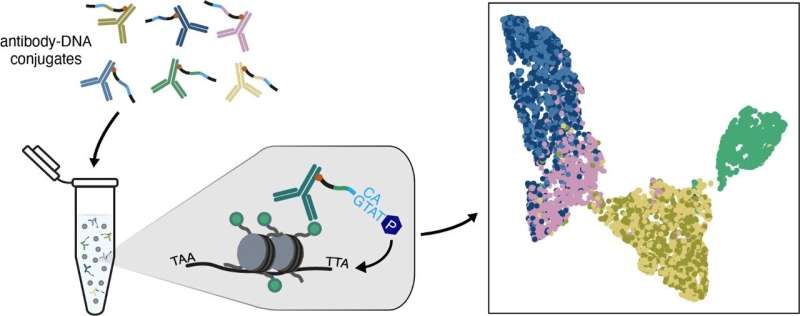This article has been reviewed according to Science X's editorial process and policies. Editors have highlighted the following attributes while ensuring the content's credibility:
fact-checked
peer-reviewed publication
trusted source
proofread
New technique efficiently offers insight into gene regulation

DNA is the most important carrier of genetic information. Each cell contains approximately two meters of DNA. To ensure that all this genetic material fits into the small cell nucleus, it must be tightly packed. The DNA is, therefore, wrapped around a special type of protein, a histone. The packages of DNA and histones are called chromatin.
Chromatin not only ensures that all the DNA fits into the cell, it also determines which parts of the genetic material can be read by the cell. For example, a piece of DNA that is tightly wrapped around the histone is more difficult to read than a piece of DNA that is packed more loosely. Ultimately, the way in which chromatin is folded determines which parts of the genetic material are expressed and which parts are not. This pattern of gene expression differs per cell type. Different genes are more active in a skin cell than in a liver cell, for example.
The activity of genes is not always the same: a different pattern of genes may be active in one moment compared to another. That is because the structure of chromatin can change. For instance, changes can occur in the histones, which are called histone modifications. Certain proteins can also bind to the chromatin. Both processes influence the readability of the DNA and, therefore, the gene expression.
In recent years, various technologies have been developed to investigate the mechanisms of gene regulation. However, there was still a technique missing to allow researchers to simultaneously look at multiple mechanisms in one cell. The group of Jop Kind, therefore designed a new technique: MAbID. With MAbID, researchers can simultaneously study multiple types of histone modifications and the proteins that bind to chromatin.
"With our new technique, we can see how the different mechanisms of gene expression are connected, for example, how they work together or against each other. And the great thing is that we no longer need separate experiments for this; we can study everything at once in each individual cell. That makes the research much more efficient," Silke Lochs, one of the researchers on the project, explains.
The technology can be widely applied. Robin van der Weide, another researcher on the project, says, "MAbID can help us answer fundamental scientific questions, for example, about how gene regulation works during the development of humans or animals. But we can also use it for research into the development of diseases that can be caused by abnormalities in gene regulation, such as cancer." The versatile new technology can, therefore in the future, provide important insights into both health and disease.
The paper, "Combinatorial single-cell profiling of major chromatin types with MAbID," is published in Nature Methods.
More information: Silke J. A. Lochs et al, Combinatorial single-cell profiling of major chromatin types with MAbID, Nature Methods (2023). DOI: 10.1038/s41592-023-02090-9
Journal information: Nature Methods
Provided by Hubrecht Institute



















